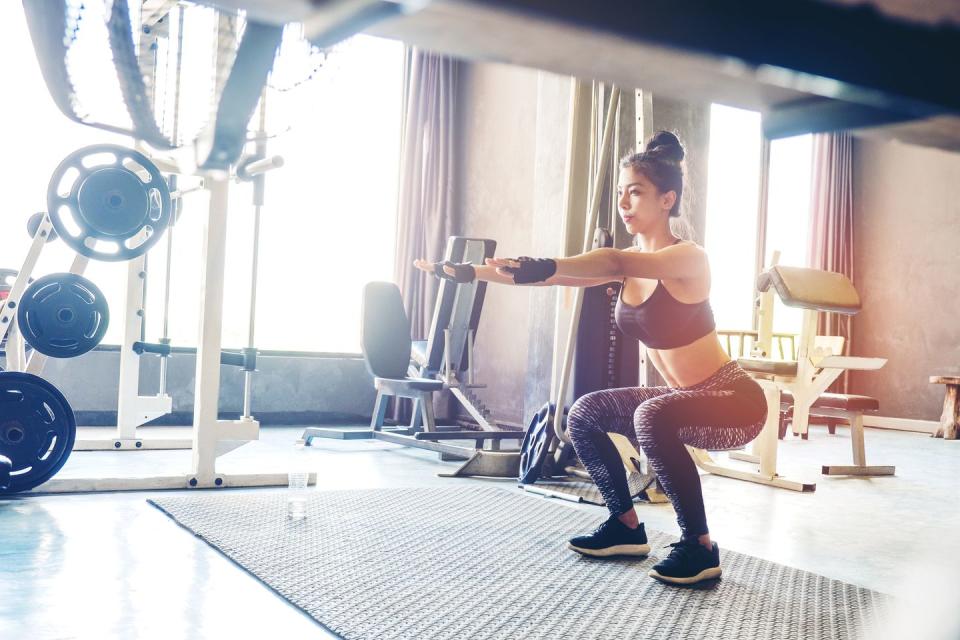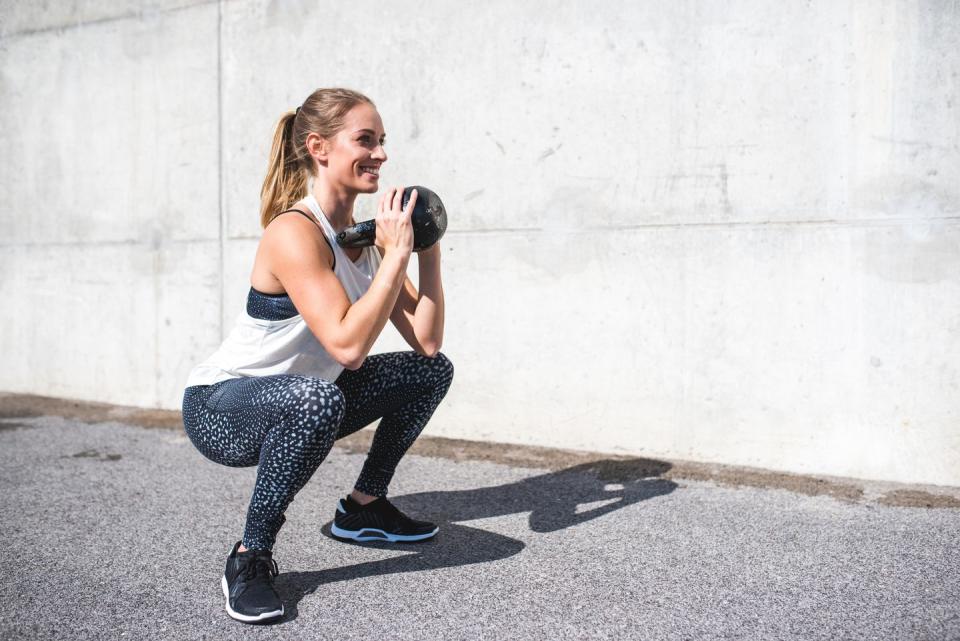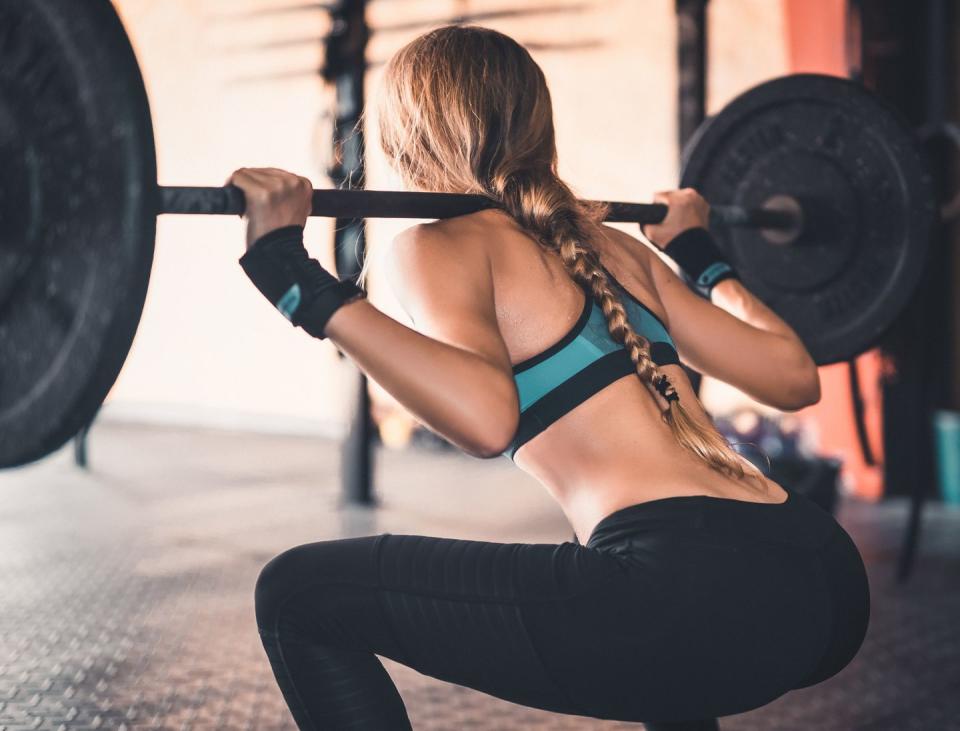How to nail the perfect squat, according to a PT

Squats are the holy grail of exercises for building a butt and strengthening the core. We all know roughly how to do one - it's basically crouching down and back up again - but because we can't all afford our own PT, we quizzed one trainer on exactly how to nail the perfect form.
You'll be pleased to know that according to Reid Stafford, a personal trainer at Ultimate Performance, "there is no single perfect way to perform the exercise". There's only a perfect way to perform a squat that works for you and your body. But follow his guide and you know you'll be on the right track.
How deep should you squat?
"The squat is a multi-joint exercise that involves moving at the hip, knee and ankle," explains Reid. "When looking at how deep to squat, what you need to look for is the depth at which the hip/bum appears to tuck under the very bottom of the spine."

You might think the lower you can go the better, but the expert reminds us that "exceeding this point by squatting further will not benefit your glute or quad strength". If you go lower than your optimum squatting depth, the movement ends up coming from flexion of the spine, which is something Reid advises you want to avoid.
"Ensure that you decelerate slowly on the way down (no dropping) and always pause at the bottom position (no bouncing) to maintain tension in the glutes and quads," the trainer adds.
How wide should you plant your feet?
"Most people will need to set their feet just outside shoulder width," notes Reid. "If you go too narrow or too wide, you will feel a pinching or blocking feeling at a certain point on the way down. This is where the femur is being blocked by the pelvis from any more movement, meaning that no more range is available."
The trainer explains that if you try to squat past this point, you'll find that the spine will start to round as you try to squat further down, which isn't what you want.
How wide you set your feet will be a personal to you, because it's based on the width of your shoulders. "The easiest way to see is to try squatting with an unloaded barbell and try different widths and see which one feels the best and allows you the most depth," suggests Reid.

What if your knees drop in?
If your knees drop when you squat, there are two things a trainer would suggest. "The first is to adopt a slightly narrower stance so that your shin, knee and upper thigh all line up in the same direction," suggests the expert, adding: "Use the mirrors to look for this when you squat down.
"Another issue may be weak inner thigh muscles. As you squat down, those inner thigh muscles are undergoing a loaded stretch. If they are weak, they will not want to lengthen any further than their strength allows. By dropping the knees in, the body is acting to protect this muscle from being over-lengthened and potential injury. Try using the Inner Thigh Adductor machine as an assistance exercise to improve squatting strength," advises Reid.
Should your back hurt when you squat?
In short: it's not ideal, but it's not uncommon. "If you have a weak core and are unable to brace efficiently, you will often find that the spine begins to round, resulting in back pain or feelings of severe discomfort," explains Reid. That's because squatting requires strength in the upper body and core to hold your body weight.
But there's something that could help (aside from building a stronger core, of course). "Learning how to take large, deep breaths in through the diaphragm and focusing on expanding the ribcage will help," Reid advises. "Also, ensure that you grip and pull down on the barbell to ensure that all of the upper back muscles help create a strong brace."

What footwear should you use for squatting?
"When squatting, you are deliberately trying to push down hard into the floor, so you want to ensure you're wearing hard-soled, rigid shoes that have very little cushion or spring," says Reid, explaining that "this allows you to create more power, but also keeps the ankle more stable. The more stable your footing, the more power you can create and the harder you can work."
"This is why I recommend to everybody not to squat in running shoes – they offer little support and are primarily designed to absorb and redistribute the landing forces in running. If you don't have any hard-soled shoes, going barefoot is the next best option," the trainer adds.
1. Take hold of the bar with an overhand, evenly spaced grip. Ensure you grip the bar firmly.
2. Step underneath the bar.
3. Position your feet under the bar, stand up and take 1-2 steps back
4. When in position, take a large, slow deep breath in and pull down on the bar (you should see your chest and ribcage expand and rise).
5. Start the movement by bending at the knee and at the hip simultaneously.
6. Squat slowly, decelerating (not dropping) until you have reached the bottom position. This is the point you cannot lower your hips any further without your heels lifting off the floor and/or your lower back rounding.
7. Pause for a moment in the bottom position, keeping tension in your legs. Do not bounce.
8. Drive hard into floor through the centre of your feet and push up until you reach the top.
9. Keep your head down slightly (think 'chin tucked in') and keep your eyes looking forward at all times.
10. Repeat for the desired number of reps. On the last rep, make sure to walk the bar back into the rack safely.
('You Might Also Like',)


